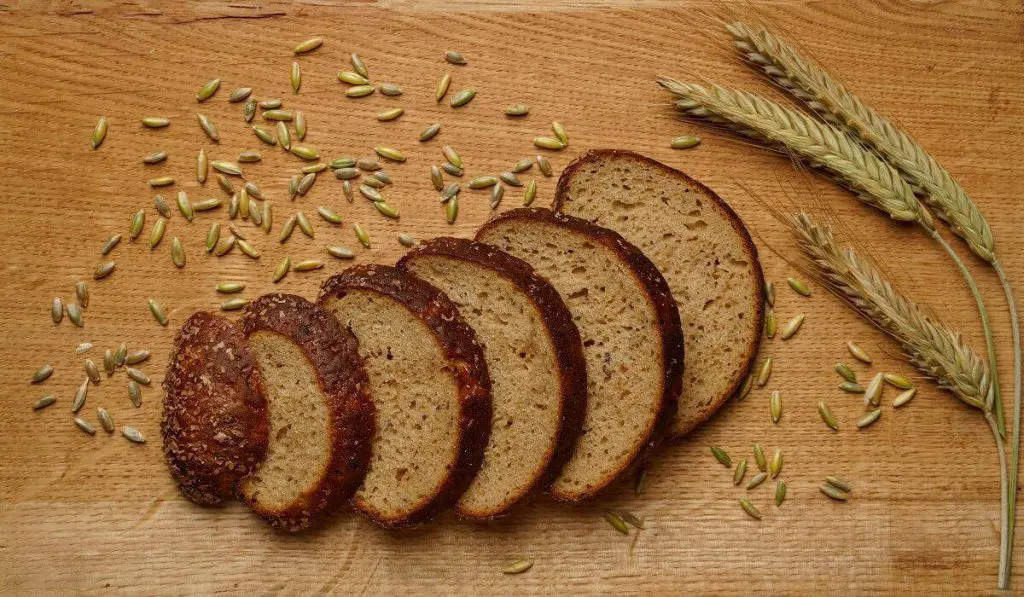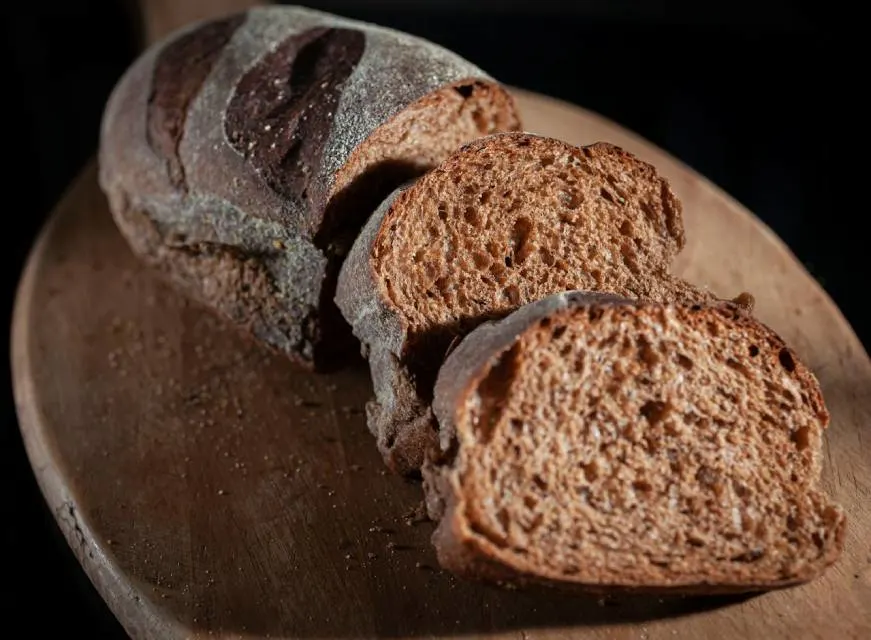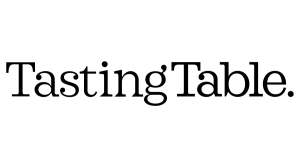
Have you ever stood in the bread aisle, pondering over the plethora of options, and found yourself asking, “Is rye bread actually healthy?” You’re not alone! This age-old question has puzzled many health-conscious bread lovers. Let’s dive into the world of rye bread and unravel this mystery.
TL;DR: Quick Rye Bread Health Facts
- Low in Calories: A slice contains about 83 calories.
- High in Dietary Fiber: Provides 15% of your daily intake.
- Low Glycemic Index: A smarter choice for blood sugar management.
- Nutrient-Rich: Packed with B vitamins and fiber.
- Diabetes and Weight Management Friendly: Thanks to its low glycemic index.
Rye Bread Nutrition Data: A Closer Look
Delving into the nutritional profile of rye bread, we find a treasure trove of health benefits. A standard slice of rye bread typically contains:
| Nutrient | Amount |
|---|---|
| Calories | Approximately 83 |
| Carbohydrates | Around 15.5 grams |
| Dietary Fiber | About 1.9 grams |
| Protein | Roughly 2.7 grams |
| Fat | Minimal, generally under 1 gram |
| Vitamins and Minerals | Rich in B vitamins, iron, magnesium, and phosphorus |
This nutritional makeup positions rye bread as a healthier alternative to many white and refined breads, supporting various aspects of health from blood sugar control to digestive well-being.
The Nutritional Powerhouse: Unveiling Rye Bread’s Secrets
Rye bread isn’t just another item on the shelf; it’s a nutritional powerhouse that’s been nourishing generations. Packed with essential nutrients, it’s more than just a component of your diet—it’s a contributor to your overall health. Let’s explore the hidden secrets of rye bread and why it’s a smart choice for your meals.
A Slice of Health: What’s Inside Rye Bread?
Rye bread, a staple in many American households, goes beyond being a tasty addition to your meals. According to the USDA, a single slice packs about 83 calories and is a dietary fiber champion, offering roughly 15% of your daily recommended intake. This high fiber content not only aids in digestion but also helps in maintaining a feeling of fullness, contributing to weight management. Additionally, rye bread is a good source of essential nutrients like magnesium, which is vital for bone health and energy production, and selenium, known for its antioxidant properties.
Blood Sugar Blues? Rye to the Rescue!
One of rye bread’s standout features is its low glycemic index. Unlike white bread, which can cause rapid spikes in blood sugar levels, rye bread takes a slow and steady approach. This quality makes it an excellent choice for those managing diabetes or watching their weight. The slow release of glucose into the bloodstream ensures a steady energy supply without the peaks and troughs associated with other types of bread. This makes rye bread an ideal option for maintaining energy levels throughout the day.
The Nutritionist’s Nod: Rye’s Wholesome Goodness
Keri Gans, a renowned nutritionist, endorses rye bread, stating, “Rye is definitely something I recommend incorporating into your diet because it’s whole grain…It’s going to provide you with more nutrients—B vitamins and fiber—than something that’s refined.” It’s richness in B vitamins, particularly niacin, thiamin, and riboflavin, plays a crucial role in converting food into energy and maintaining healthy skin and vision.
Rye Bread: A Versatile, Healthy Choice
Rye bread transcends the ordinary, offering a world of culinary possibilities beyond the traditional sandwich. Its unique flavor and texture make it a versatile ingredient for a variety of dishes, enhancing both taste and nutrition.
Beyond the Sandwich: Creative Ways to Enjoy Rye
Rye bread isn’t just for sandwiches. Unleash your culinary creativity and explore its versatility. Transform your breakfast with rye bread avocado toasts, topped with a sprinkle of chili flakes and a drizzle of olive oil for a healthy start. For lunch, consider rye bread as a robust base for hearty bruschettas, layered with fresh tomatoes, basil, and a touch of garlic. And for a twist on traditional snacks, try using thinly sliced rye bread as a crunchy addition to your morning cereal or granola, adding a delightful texture and fiber boost.
The American Rye Bread Scene: A Cultural Staple
In the United States, rye bread has woven its way into the fabric of our culinary culture. It’s not just a bread; it’s a part of our heritage. From the classic Reuben sandwiches found in New York delis to innovative gourmet creations in trendy cafes, rye bread is a versatile and beloved ingredient. Its distinct flavor complements a variety of ingredients, making it a favorite for chefs and home cooks alike. Whether it’s paired with corned beef and sauerkraut in a Reuben or used as a base for an elegant smoked salmon appetizer, rye bread consistently delivers a unique and satisfying experience.

Personal Insights and Uncommon Angles
Diving into the world of rye bread, we uncover truths and debunk myths, offering a fresh perspective on this wholesome grain. Here are some personal insights and lesser-known facts about rye bread that might surprise you.
Rye Bread Myths Debunked
There’s a lot of misinformation out there about rye bread. Contrary to popular belief, it’s not just a fancier version of white bread. Rye bread is a whole grain powerhouse, rich in nutrients and flavor. It’s a common misconception that rye bread is heavy and dense; however, when baked correctly, it can be light and airy with a distinctive taste. Another myth is that rye bread is always dark and bitter, but in reality, the color and flavor can vary significantly depending on the type of rye used and the baking process.
Insider Tips: Making the Most of Rye
As an experienced rye bread journalist, I’ve gathered some insider tips to enhance your rye bread experience. For the freshest taste and texture, I recommend buying your rye bread from local bakeries where it’s often baked daily. Don’t hesitate to ask the baker about the type of rye used, as this can greatly influence the bread’s flavor profile. Experimenting with different rye varieties can be a delightful culinary adventure. Light rye tends to be milder and softer, perfect for those new to rye bread, while dark rye offers a more intense flavor and denser texture, ideal for robust sandwiches or toasting.
Conclusion: Rye Bread, A Healthy Choice
Rye bread transcends being a mere kitchen staple; it’s a nutritional powerhouse, a versatile culinary asset, and a cultural emblem. Characterized by its low calorie content, high dietary fiber, and a low glycemic index, rye bread emerges as a health-conscious choice, especially beneficial for those with diabetes or those focused on weight management. Its ability to regulate blood sugar and promote fullness makes it a valuable dietary inclusion.
Nutritionally, rye bread is laden with B vitamins, iron, magnesium, and phosphorus, playing a pivotal role in overall health. It aids in digestion, energy production, and offers antioxidant benefits, making it a vital source of essential nutrients.
Culinarily, rye bread is celebrated for its unique flavor and texture, making it a versatile ingredient in various recipes. From innovative culinary creations to traditional favorites like the Reuben sandwich, rye bread holds a special place in American cuisine. It enhances meals, turning them into memorable experiences.
Debunking common myths about rye bread, it’s clear that it’s more than just an alternative to white bread. It’s a whole grain with distinct qualities, deserving of recognition and appreciation.
In summary, incorporating rye bread into our diets is a nod to healthier eating, rich flavors, and cultural heritage. It’s a choice that nurtures our body, pleases our palate, and connects us to a wider culinary narrative. With its deep roots and adaptable nature, rye bread stands out as a healthy, enjoyable option for everyone, embodying a blend of nutrition, taste, and tradition.
FAQs About Rye Bread
Is Rye Bread Good for Weight Loss?
Yes, its low glycemic index and high fiber content make it a great choice for weight management.
Can Diabetics Safely Eat Rye Bread?
Absolutely! Rye bread’s low glycemic index helps maintain stable blood sugar levels.
How Does Rye Bread Affect Digestion?
Thanks to its high fiber content, rye bread aids in digestion and can help prevent constipation.
Are There Different Types of Rye Bread?
Yes, there are several varieties, each with its own unique taste and texture.
How Can I Incorporate Rye Bread into My Diet?
Try it as a base for sandwiches, toasts, or even as a crunchy addition to salads.
Is Rye Bread Better Than White Bread?
Nutritionally, yes. Rye bread is richer in fiber and nutrients compared to white bread.
Can Rye Bread Help in Managing Cholesterol?
Yes, its high fiber content can aid in lowering bad cholesterol levels.
Is Rye Bread Gluten-Free?
No, it contains gluten, so it’s not suitable for those with celiac disease or gluten intolerance.
How Long Does Rye Bread Stay Fresh?
Properly stored, rye bread can stay fresh for about 4-5 days.
Can I Make Rye Bread at Home?
Yes, making rye bread at home is a rewarding and delicious endeavor!
Join Us and Transform >
Don’t Be an Amateur! Master the Art of Sourdough Bread!




Sandra, your post really resonated with me! I too have experienced the transformational power of mindful meditation, just as you described. Your point about its impact on reducing stress and improving focus is spot on. However, I wonder how you manage to maintain consistency in your practice? And do you have any specific tips for beginners who are struggling to incorporate it into their daily routine? I believe readers would find it beneficial. Additionally, I’ve found that pairing meditation with yoga adds a physical aspect that enhances the overall experience. Have you tried that?
I remember when I first started meditating, I was a bit skeptical. But after a few weeks, I could already notice a significant difference in my overall well-being. It’s been a game-changer for me, and your post validates my experience. Keep sharing these enlightening posts, Sandra! 🙏😊